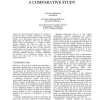Free Online Productivity Tools
i2Speak
i2Symbol
i2OCR
iTex2Img
iWeb2Print
iWeb2Shot
i2Type
iPdf2Split
iPdf2Merge
i2Bopomofo
i2Arabic
i2Style
i2Image
i2PDF
iLatex2Rtf
Sci2ools
SCHOLARPEDIA
2008
2008
Computational models of classical conditioning
: We describe computer simulation of a number of associative models of classical conditioning in an attempt to assess the strengths and weaknesses of each model. The behavior of the Sutton-Barto model, the TD model, the Klopf model, the Balkenius model and the SchmajukDiCarlo model are investigated in a number of simple learning situations. All models are shown to have problems explaining some of the available data from animal experiments. The ISI curves for trace and delay conditioning for all the models are presented together with simulations of acquisition and extinction, reacquisition, blocking, conditioned inhibition, secondary conditioning and facilitation by an intermittent stimulus. We also present cases where some of the models show an unexpected behavior. Although traditionally seen as a very simple phenomenon, classical conditioning has offered unexpected resistance to theoreticians. Still, almost a hundredyears after Pavlov's initial experiments, there exist no model c...
Related Content
| Added | 28 Dec 2010 |
| Updated | 28 Dec 2010 |
| Type | Journal |
| Year | 2008 |
| Where | SCHOLARPEDIA |
| Authors | Nestor A. Schmajuk |
Comments (0)

